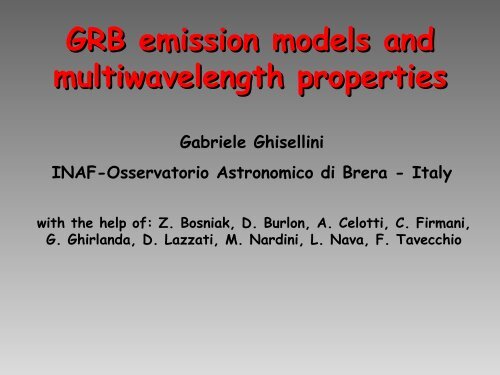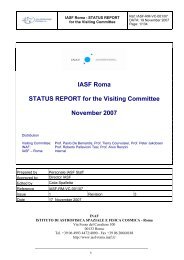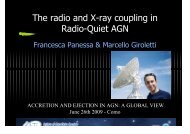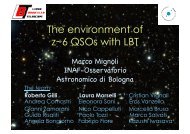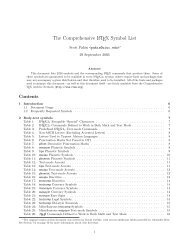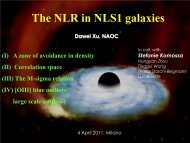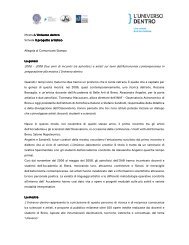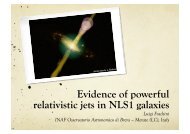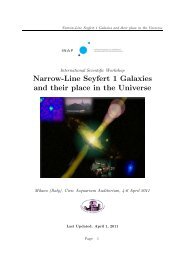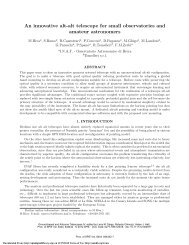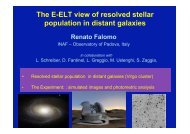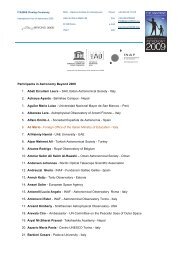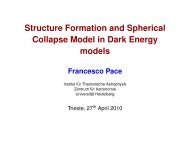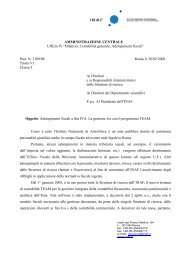GRB emission models and multiwavelength properties - Inaf
GRB emission models and multiwavelength properties - Inaf
GRB emission models and multiwavelength properties - Inaf
Create successful ePaper yourself
Turn your PDF publications into a flip-book with our unique Google optimized e-Paper software.
<strong>GRB</strong> <strong>emission</strong> <strong>models</strong> <strong>and</strong><br />
<strong>multiwavelength</strong> <strong>properties</strong><br />
Gabriele Ghisellini<br />
INAF-Osservatorio Astronomico di Brera - Italy<br />
with the help of: Z. Bosniak, D. Burlon, A. Celotti, C. Firmani,<br />
G. Ghirl<strong>and</strong>a, D. Lazzati, M. Nardini, L. Nava, F. Tavecchio
The “st<strong>and</strong>ard” model
“The” model:<br />
Internal/External<br />
Shocks<br />
Rees-Meszaros-Piran<br />
Shell still opaque<br />
Relativ. e - + B:<br />
synchrotron<br />
Relativ. e - + B:<br />
synchrotron
Why internal shocks<br />
Spikes have<br />
same duration<br />
A process<br />
that repeats<br />
itself<br />
Counts/s<br />
Time [seconds]
Spectra<br />
E F(E)<br />
<br />
E peak<br />
Energy [MeV]<br />
<br />
Fishman & Meegan 1995
Kaneko+ 2006<br />
[keV]
Nava PhD thesis 2009 Kaneko+ 2006<br />
[keV]
Prompt radiation:<br />
Synchrotron
Synchrotron -ray <strong>emission</strong><br />
The shell itself carries B-field<br />
B can also be produced <strong>and</strong> amplified<br />
by the internal shock<br />
The shock can accelerate e- to<br />
relativistic energies<br />
Synchrotron seems a good choice<br />
hsyn ~ a few hundreds keV seems<br />
reasonable
Synchrotron -ray <strong>emission</strong><br />
Radiative cooling is (<strong>and</strong> must be)<br />
very rapid<br />
tcool ~ 10 - 7<br />
3<br />
e<br />
(/100)<br />
2<br />
MeV<br />
sec<br />
Extremely short - No way to make it longer<br />
t cool<br />
Energy spectrum of a cooling electron<br />
Fast cooling<br />
+ synchro:<br />
E() ¿ -1/2<br />
¿<br />
N() -3/2<br />
Photon index
Kaneko+ 2006
Kaneko+ 2006 Nava PhD thesis 2009<br />
Line of death for<br />
cooling e-<br />
Line of death for<br />
non cooling e-
Can it be rescued by:<br />
Reacceleration No, in IS e- are accelerated only<br />
once. More generally, only few selected e- (<strong>and</strong><br />
always the same) must be (re)accelerated<br />
Adiabatic losses No, too small regions would be<br />
involved, large e- densities, too much IC<br />
Fast decaying B-field No, synchro not efficient <strong>and</strong><br />
too much IC<br />
Self absorption No, lots of e- needed, too much IC<br />
Self Compton No, tcool Small pitch angles No,<br />
too small even in this case<br />
No, Very very small to avoid<br />
cooling, becomes inefficient<br />
External shocks to avoid cooling No, same reason
Seeking alternatives…<br />
• Bulk Compton (Lazzati+ 2000; GG+ 2000)<br />
• Quasi-thermal Comptonization (GG &<br />
Celotti 1999)<br />
• Black-body from “deep impacts”<br />
(Thompson+2007; GG+ 2007; Lazzati+ 2009)<br />
• Reconnection <strong>and</strong> continuous heating<br />
(Giannios 2008)
Seeds <br />
Wolf Rayet (about<br />
to explode)<br />
<br />
Bulk Compton<br />
100
Problems<br />
• Time to refill the funnel of seeds<br />
• Needs a lot of seeds, not clear if the<br />
funnel is sufficient<br />
• Does not work for short (they do not<br />
have a SN)
Quasi thermal Componization<br />
• Heating for r/c, not instantaneous<br />
acceleration<br />
• Cooling=Heating<br />
sub-relat. “T”<br />
• Synchro is self absorbed <strong>and</strong> produces<br />
seeds for quasi saturated<br />
Comptonization<br />
• y needs to be >10
Quasi-saturated spectrum: 0 +Wien
Problems<br />
• Epeak ~ kT too high<br />
• Needs time ((<br />
must be large)<br />
• Wien peak not observed<br />
• Seeds should be distributed in the<br />
center, e- more externally, to explain<br />
>-1
“Deep impacts”<br />
Thompson, Meszaros & Rees 2007<br />
Lazzati, Morsony Begelman 2008<br />
GG+ 2007<br />
At R ~ R star the fireball dissipates<br />
part of its energy BB
Dissipation<br />
Wolf Rayet (about<br />
to explode)<br />
BB<br />
Transparency<br />
1 j<br />
(i.e very small)
Problems<br />
fine tuned (<strong>and</strong> small) in Thompson+ 2008<br />
BB
There can be a Black Body … but<br />
BATSE<br />
Time integrated<br />
spectrum<br />
BB<br />
power law<br />
Cut Cut off off pl pl<br />
Time resolved<br />
spectra<br />
30 keV<br />
Ghirl<strong>and</strong>a+ 2007
There can be a Black Body … but<br />
BATSE<br />
Time integrated<br />
spectrum<br />
BB<br />
power law<br />
Cut Cut off off pl pl<br />
30 keV<br />
Time resolved<br />
spectra<br />
The same occurs<br />
for ALL <strong>GRB</strong>s<br />
detected by<br />
BATSE <strong>and</strong> with<br />
WFC<br />
Ghirl<strong>and</strong>a+ 2007
FERMI-GBM<br />
FERMI-GBM<br />
Cutoff PL<br />
Ghirl<strong>and</strong>a+ 2009<br />
30 keV
FERMI-GBM<br />
FERMI-GBM<br />
BB+PL<br />
Ghirl<strong>and</strong>a+ 2009<br />
30 keV
FERMI-GBM<br />
FERMI-GBM<br />
Cutoff PL<br />
Ghirl<strong>and</strong>a+ 2009
FERMI-GBM<br />
FERMI-GBM<br />
BB+PL<br />
The The same same occurs occurs for for all all time time slices slices<br />
Ghirl<strong>and</strong>a+ 2009
Reconnection <strong>and</strong> continuous<br />
heating (Giannios 2008)<br />
1 MeV<br />
Very promising, especially for<br />
magnetized fireballs, but….
Reconnecting regions should<br />
behave r<strong>and</strong>omly
Reconnecting regions should<br />
behave r<strong>and</strong>omly<br />
Instead there are trends
E peak [keV] Rate<br />
peak<br />
=k L 1/2<br />
E peak<br />
1/2<br />
Ghirl<strong>and</strong>a+ 2009<br />
FERMI-GBM<br />
Luminosity [erg/s]
How to explain it<br />
It is NOT DUE to selection effects!!!!!!<br />
It indicates something fundamental <strong>and</strong><br />
very robust… that we do not<br />
underst<strong>and</strong> yet.<br />
Geometrical Difficult<br />
Sequence of Difficult<br />
Radiation process Likely, but which<br />
one
First conclusion<br />
• We do not know yet what is<br />
the <strong>emission</strong> mechanism of the<br />
prompt
Fermi-LAT<br />
<strong>GRB</strong> 090510<br />
• Short<br />
• Very hard<br />
• z=0.903<br />
• Detected by the LAT up to 31 GeV!!<br />
• Well defined timing<br />
• Delay: ~GeV arrive after ~MeV (fraction of<br />
seconds)<br />
• Quantum Gravity Violation of Lorentz<br />
invariance
precursor<br />
8-260 keV<br />
0.26-5 MeV<br />
LAT all<br />
>100 MeV<br />
Abdo et al 2009<br />
0.6s<br />
0.5s<br />
31 GeV<br />
>1 1 GeV<br />
Time since trigger (precursor)
precursor<br />
8-260 keV<br />
0.26-5 MeV<br />
Delay between GBM <strong>and</strong> LAT<br />
Due to Lorentz invariance<br />
violation<br />
LAT all<br />
>100 MeV<br />
Abdo et al 2009<br />
0.6s<br />
0.5s<br />
31 GeV<br />
>1 1 GeV<br />
Time since trigger (precursor)
Average<br />
0.1 GeV<br />
30 GeV<br />
F( F() [erg/cm 2 /s]<br />
Time<br />
resolved<br />
0.5-1s<br />
1<br />
2<br />
Different component<br />
3<br />
4<br />
3<br />
Abdo et al 2009<br />
Energy [keV]
Average<br />
0.1 GeV<br />
30 GeV<br />
F( F() [erg/cm 2 /s]<br />
Time<br />
resolved<br />
1<br />
2<br />
Different component<br />
3<br />
0.5-1s<br />
3<br />
If LAT <strong>and</strong> GBM radiation are cospatial:<br />
4<br />
If LAT <strong>and</strong> GBM radiation are cospatial: <br />
>1000 to avoid photon-photon absorption<br />
If >1000: deceleration of the fireball<br />
occurs early early afterglow!<br />
If >1000: large electron energies <br />
synchrotron afterglow!<br />
Abdo et al 2009<br />
Energy [keV]
Fermi-LAT<br />
t 2<br />
“Signature”<br />
t -1.5<br />
Ghirl<strong>and</strong>a+ 2009
0.1-1 GeV<br />
>1 GeV<br />
Ghirl<strong>and</strong>a+ 2009<br />
T-T* [s]
T-T* [s]<br />
Ghirl<strong>and</strong>a+ 2009
~MeV <strong>and</strong> ~GeV <strong>emission</strong> are NOT cospatial.<br />
But the ~GeV <strong>emission</strong> is… No measurable<br />
delay in arrival time of high energy photons:<br />
tdelay 4.7 M Planck<br />
Ghirl<strong>and</strong>a+ 2009<br />
T-T* [s]
Conclusions<br />
“Paradigm”: internal+external shocks,<br />
synchrotron for both: it does not<br />
work<br />
Problems: efficiency, spectrum, trends<br />
Fermi/LAT detection large Early<br />
high energy afterglow<br />
Violation of the Lorentz invariance<br />
Violation of the Lorentz invariance No<br />
(not yet)


